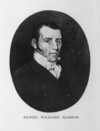LAND, ROBERT, pioneer, farmer, militia officer, and public servant; b. 10 April 1772 in Pennsylvania, sixth of the seven children of Robert Land and Phebe Scott; m. Hannah Horning of Barton Township, Upper Canada, and they had nine children; d. 21 Nov. 1867 at Hamilton, Ontario.
Robert Land, who is sometimes also designated Jr or II to avoid confusion with his father and second son, fled with his mother, a sister, and a younger brother from what is now Wayne County, Pennsylvania, to New York in May 1779 for protection from rebel harassment after his father, a magistrate under the colonial government of Pennsylvania, joined the British forces as a dispatch carrier. In 1783, while his father was based at Niagara (Niagara-on-the-Lake), Robert and the others embarked with the first fleet of loyalists for the Saint John River (New Brunswick) where his mother was granted 200 acres of land at Parr Town (Saint John). In 1791 they made their way to Upper Canada and joined Robert Land Sr who, in the meantime, had become one of the first settlers at the Head-of-the-Lake (later Hamilton).
As “the son of a zealous and active Loyalist,” Robert Jr petitioned for land in 1795 and was granted 200 acres in Middlesex County. Following military service in 1812–14, he received an additional 500 acres in Caledon Township (Peel County). He lived in Barton Township on land originally granted to his father, farming several hundred acres in the area.
In 1804 Land had begun a military career that was to span a period of 43 years by joining the West Lincoln militia as lieutenant. When the War of 1812–14 began, he entered the 5th Lincoln militia as lieutenant in Samuel Hatt*’s company of flankers and was granted a medal and clasp for action at the surrender of Detroit. On the morning of the battle at Queenston Heights, 13 Oct. 1812, his company was the only force present at Queenston. He next took part in the skirmish at Frenchman’s Creek. At Stoney Creek, acting under orders of Colonel John Harvey*, he is credited with helping to prevent a junction between American troops landed at Burlington Beach and the main force at Stoney Creek. After the battle of Lundy’s Lane, Land, his nephew Joseph Birney, and Major Hatt, were recommended for the medal of the Loyal and Patriotic Society by their commanding officer, Colonel Andrew Bradt, having behaved “with every mark of intrepidity during the action saving the Major who was severely wounded.” After the war Land maintained his active connection with the militia; he was gazetted lieutenant-colonel of the 3rd Gore militia in 1830, and commanded the post at Hamilton during the rebellion of 1837–38. In 1847, at age 75, he retired from command of the 2nd Wentworth militia.
Land was appointed commissioner of customs for the Gore District in 1834; he was reappointed in 1840 and resigned in 1847. He also served as postmaster for the district for a period around 1847. He was appointed general commissioner of the peace on four occasions between 1827 and 1838, and an associate justice of the Court of Oyer and Terminer and General Gaol Delivery for the counties of Wentworth, Halton, and Brant on 12 March 1852. Land was a member of the Church of England and the Masonic Order; he had been initiated in the Barton Lodge on 7 Nov. 1796 and at his death was believed to be the oldest mason in Canada.
He died at his home and was given a funeral on 24 Nov. 1867 attended by “the Volunteers of the City, together with the mayor and civic authorities, and a large representation of the Masonic fraternity.” “A very large number of private citizens joined in the procession and thus lent testimony to the great respect in which the deceased gentleman was held by all classes of the community with which he has been so long identified.”
HPL, Land papers; Land family papers. PAC, RG 1, L3, L, bundle 1, no.55. PAO, Strachan (John) papers, Andrew Bradt to C. Foster, 25 Jan. 1815. Daily Spectator (Hamilton), 22, 25 Nov. 1867. I. L. Alton, Descendants of Robert Land, 1736–1818, & Phebe Scott, 1733–1826 ([Burlington, Ont., 1970?]). George Laidler, “The story of the Land family,” Wentworth Bygones (Hamilton, Ont.), 1 (1958), 14–26.
© 1976–2024 University of Toronto/Université Laval
Cite This Article
R. Brian Land, “LAND, ROBERT,” in Dictionary of Canadian Biography, vol. 9, University of Toronto/Université Laval, 2003–, accessed April 23, 2024, http://www.biographi.ca/en/bio/land_robert_9E.html.
The citation above shows the format for footnotes and endnotes according to the Chicago manual of style (16th edition). Information to be used in other citation formats:
| Permalink: | http://www.biographi.ca/en/bio/land_robert_9E.html |
| Author of Article: | R. Brian Land |
| Title of Article: | LAND, ROBERT |
| Publication Name: | Dictionary of Canadian Biography, vol. 9 |
| Publisher: | University of Toronto/Université Laval |
| Year of publication: | 1976 |
| Year of revision: | 1976 |
| Access Date: | April 23, 2024 |







